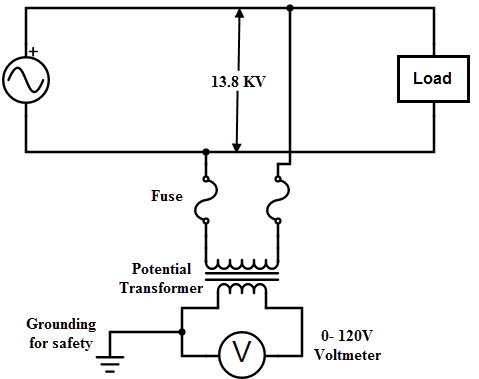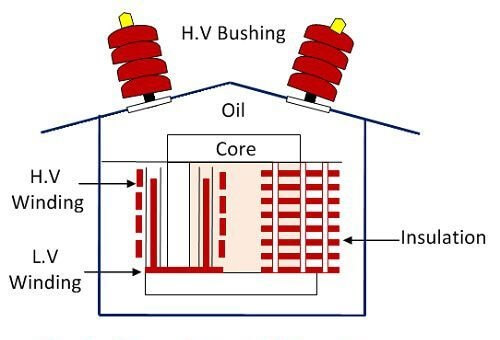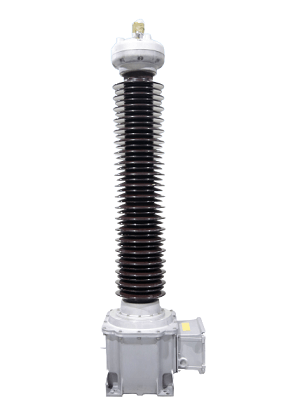In addition to the reduction of voltage and current levels, these transformers isolate the measuring or protective circuit from the main circuit which is operating at high power levels. The current transformers reduce the level of current to the instrument or relay operating range, whereas potential transformers transforms the high voltage to a circuit operating low voltage. In this article we are going to discuss in detail about the potential transformers.
What is Potential Transformer
Potential transformer is a voltage step-down transformer which reduces the voltage of a high voltage circuit to a lower level for the purpose of measurement. These are connected across or parallel to the line which is to be monitored. The basic principle of operation and construction of this transformer is similar to the standard power transformer. In common, the potential transformers are abbreviated as PT.
The primary winding consists of a large number of turns which is connected across the high voltage side or the line in which measurements have to be taken or to be protected. The secondary winding has lesser number of turns which is connected to the voltmeters, or potential coils of wattmeter and energy meters, relays and other control devices. These can be single phase or three phase potential transformers. Irrespective of the primary voltage rating, these are designed to have the secondary output voltage of 110 V. Since the voltmeters and potential coils of other meters have high impedance, a small current flows through the secondary of PT. Therefore, PT behaves as an ordinary two winding transformer operating on no load. Due to this low load (or burden) on the PT, the VA ratings of PTs are low and in the range of 50 to 200 VA. On the secondary side, one end is connected to the ground for safety reasons as shown in figure. Similar to the normal transformer, the transformation ratio is specified as V1/V2 = N1/N2 From the above equation, if the voltmeter reading and transformation ratio are known, then high voltage side voltage can be determined.
Construction
Compared to the conventional transformer, potential transformers or PTs use larger conductor sizes and core. PTs designed for ensuring the greater accuracy and hence, at the time of designing economy of the material is not considered as main aspect. PTs are made with special high quality core operating at lower flux densities in order to have small magnetising current so that no load losses are minimised. Both core and shell type constructions are preferred for PTs. For high voltages, core type PTs are used while shell type is preferred for low voltages. To reduce the leakage reactance, co-axial windings are used for both primary and secondary. For reducing the insulation cost, low voltage secondary winding is placed next to the core. And for high voltage PTs, high voltage primary is divided into sections of coils to reduce the insulation between coil layers. For these windings, vanished cambric and cotton tape are used as laminations. In between the coils, hard fiber separators are used. These are carefully designed to have minimum phase shift between the input and output voltages and also to maintain a minimum voltage ratio with variation in load. Oil filled PTs are used for high voltage levels (above the range of 7KV). In such PTs, oil filled bushings are provided to connect the main lines.
Types of Voltage or Potential Transformers
Majorly these are classified into outdoor and indoor potential transformers.
1. Outdoor Potential Transformers
These can be single or three phase voltage transformers available for different range of operating voltages that are used for outdoor relaying and metering applications. Up to 33KV, these are of electromagnetic type single and three phase voltage transformers. Above 33KV single phase outdoor potential transformers can be two types electromagnetic type and capacitive voltage transformer (CVT).
Electromagnetic or Wound Type Conventional Potential Transformer
These are similar to the conventional oil filled wire wound transformers. The figure below shows the electromagnetic type of PT wherein tap tank is connected to the line terminal. A plug is provided on the tank to fill the oil and this tank is mounted on an insulator support. At the base, ground terminal and oil drain plug is provided. In this, primary is connected between the two phases or between one phase and ground. So one end of the primary is connected to main line at the top and the other end is brought out at the bottom and is grounded with other ground terminals. The secondary terminals including earth terminal are located in the terminal box at the bottom, further these are connected to the metering and relay circuits. These are used up to or below 132 KV operating voltages due to insulation aspects.
Capacitive Voltage Transformers (CVTs)
It is a capacitive potential divider connected between the phase of main line and ground. These can be coupling capacitor or bushing type CVTs. These two types are electrically less or more similar, but the difference is that the formation of capacitance which further decides their rated burden (or load). A coupling capacitor type consists of a stack of series connected capacitors which are made up of oil-impregnated paper and aluminium foil. For desired primary and secondary voltages, primary and secondary terminals are connected across the capacitors. The bushing type CVT uses condenser type bushings provided with tapping. CVTs are also used for power line carrier communication and hence more economical.
2.Indoor Potential Transformers
These are also available as single or three phase PTs which are of moulded, magnetic type. The mounting mechanism can be fixed or drawout type. In this type of PTs, all parts of primary winding are insulated from earth at its rated insulation capacity. These are designed to operate relays, measuring instruments, and other control devices in indoor service with high accuracy. Based on the function, PT or voltage transformers are classified into metering voltage transformers and protection voltage transformers.
Errors in Voltage Transformer
For an ideal voltage transformer, the voltage produced in the secondary winding is an exact proportion to the primary voltage and are exactly in phase opposition. But in actual PTs this is not so because of the presence of voltage drops in primary and secondary resistance and also due the power factor of the burden on secondary. This causes to occurrence of ratio and phase angle errors in voltage transformers. Let us know in detail. Consider the phasor diagram of potential transformer shown above, where Io = No load current Im = magnetizing component of no load current Iu = Wattful component of no load current Es and Ep = Induced voltages in secondary and primary windings respectively Np and Ns = Number of turns in primary and secondary windings respectively Ip and Is = Primary current and secondary current Rp and Rs = Resistances of primary and secondary windings respectively Xp and Xs = Reactances of primary and secondary windings respectively β = Phase angle error The primary induced voltage or EMF Ep is derived by subtracting the primary resistive (IpRp) and reactive drop (IpXp) from the primary voltage Vp. And also, secondary terminal voltage Vs is derived by subtracting secondary winding resistance drop (IsRs) and reactance drop (IsXs) vectorially from secondary induced EMF Es. Due to these drops nominal ratio of the potential transformer is not equal to the actual ratio of the PT, hence introduces a ratio error.
Ratio Error
The ratio error of the potential transformer is defined as the variation in actual ratio of transformation from nominal ratio. Percentage Ratio Error = (Kn – R) / R × 100 Where Kn is the nominal or rated transformation ratio and is Kn = Rated primary voltage / Rated secondary voltage
Phase Angle Error
In ideal PT, there should not exist any phase angle between the primary voltage and reversed secondary voltage. But in practice, there exist a phase difference between Vp and Vs reversed (as we can observe in above figure), thereby, introduces phase angle error. It is defined as the phase difference between the primary voltage and reversed secondary voltage. In order to reduce these errors such that the accuracy is improved by designing the transformers in such a way that they windings have appropriate magnitudes of internal resistance and reactances. In addition to this, the core should require minimum magnetizing and core loss components of exciting current.
Applications of Voltage Transformers
Electrical Metering systems Electrical protection systems Distance protection of feeders Synchronizing generators with grid Impedance protection of generators
The class of potential transformers used for metering is called as measurement voltage or potential transformers. On other hand PTs used for protection called as protection voltage transformers. In some cases PTs are used for both metering and protection purposes, in such cases, one secondary winding is connected to metering and other secondary winding is used for protection. Comment * Name * Email * Website
Δ










![]()